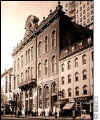 |
New York
Architecture Images- Gone Tammany Hall |
|
architect |
|
|
location |
North Side of 14th Street, East of Broadway |
|
date |
1867 |
|
style |
Italianate |
|
construction |
Rendered brick. |
|
type |
Theater
Club This auditorium was housed in the headquarters of New York's infamous political machine, Tammany Hall. It held legitimate productions from 1869 to 1876. |
|
|
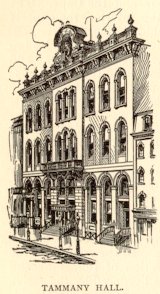 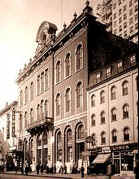 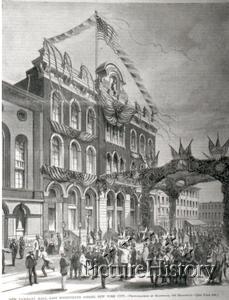 |
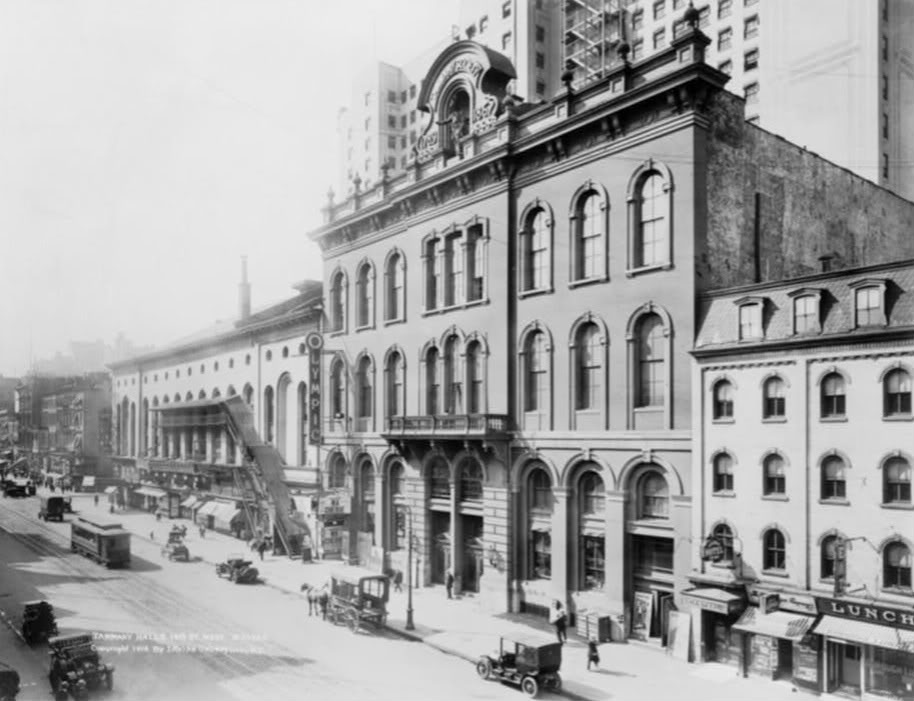 |
|
|
Tammany Hall was the name given to the
Democratic Party political machine that dominated New York City politics
from the mayoral victory of Fernando Wood in 1854 through the election
of Fiorello LaGuardia in 1934. The eighty-year period between those two
elections marks the time in which Tammany was the city's driving
political force, but its origins actually date to the late 18th century
and its fall from power was not truly complete until the early 1960s. The Tammany Society of New York City was founded in 1786 as a patriotic fraternal organization whose primary activities were social, with an initial movement within the society to improve the image of Native Americans. The name "Tammany" is that of a Native American leader of the Lenape. By 1798, however, the Society's activities had grown increasingly politicized and eventually Tammany emerged as the central proponent of anti-Federalist Jeffersonian policies in the city of New York. Aaron Burr organized the Tammany society as his political machine for the election of 1800. Throughout the early 19th century Tammany continued to deepen its association with the Democratic Party, emerging as the controlling interest in New York City elections after Andrew Jackson's presidential victory in 1828. Throughout the 1830s and 1840s the Society expanded its political control even further by earning the loyalty of the city's ever-expanding immigrant community, a task that was accomplished by helping newly-arrived foreigners obtain jobs, a place to live, and even citizenship so that they could vote for Tammany candidates in city and state elections. The mass immigrant constituency primarily functioned as an expendable base of political capital. Recognizing that Irish immigrants were inundating the city at an unprecedented rate, Tammany Hall introduced themselves to the Irish in a very profound manner for several reasons. Considering that the Irish could speak English and possessed a relatively good working knowledge of republican government, they were immediately identified as a potential gold-mine of political clout. However, the most advantageous aspect of the Irish as Tammany's major constituency was the fact that the Irish possessed little to no skills that translated into actual employment opportunities. Consequently, Tammany offered a great deal in terms of political graft and spoils to the Irish in exchange for their votes. This pattern of "logrolling" one's political conscience in exchange for employment gain would become a common theme for Tammany Hall for years to follow. By 1854 all these factors had combined to make Tammany a political force of hegemonic proportions in New York City, conferring immense power on the Society's "bosses" and allowing them to enrich themselves and their associates through corruption and administrative abuse. William M. "Boss" Tweed's infamously corrupt reign was nefarious enough to incite an attempt at reform in the early 1870s. Rutherford B. Hayes's involvement in this effort contributed to his success in the election of 1876, but Tammany was consistently able to function in spite of this and continued to direct the flow of money, patronage, and votes into the early 1930s. Ultimately, even Tammany was unable to escape from the drastic social and cultural changes brought on by the Great Depression, and in 1932 the machine suffered a dual setback when Mayor James Walker was forced from office and Franklin D. Roosevelt was elected president. The New Deal helped alter the demographic landscape of New York by restricting immigration and making people less dependent on Tammany for jobs and assistance, while the election of Fiorello LaGuardia removed the City Hall from Tammany's immediate control. Despite these setbacks, the Tammany machine achieved something of a renaissance in the early 1950s under the leadership of Carmine DeSapio, who succeeded in engineering the elections of Robert Wagner, Jr. in 1953 and Averill Harriman in 1954, while simultaneously blocking the successful candidacies of those who had not curried his favor. Perhaps most notably among these politicians was Franklin D. Roosevelt, Jr., whose defeat in the 1954 race for New York Attorney General was related to DeSapio's downstate mobilization against his election. Inadvertently, DeSapio had sown the seeds of his own ruin. Eleanor Roosevelt held DeSapio responsible for her son's defeat and grew increasingly disgusted with his political conduct through the rest of the 1950s. She joined with her old friends Herbert Lehman and Thomas Finletter to form the New York Committee for Democratic Voters, a group dedicated to enhancing the democratic process by opposing DeSapio's reincarnated Tammany. Their efforts were eventually successful and in 1961 DeSapio was removed from power. The once mighty Tammany political machine, now deprived of its leadership, quickly faded from political importance and by the mid-1960s had ceased to exist. Leaders of Tammany Hall 1797 – 1804 Aaron Burr 1804 – 1814 Teunis Wortmann 1814 – 1817 George Buckmaster 1817 – 1822 Jacob Barker 1822 – 1827 Stephen Allen 1827 – 1828 Mordecai M. Noah 1828 – 1835 Walter Bowne 1835 – 1842 Isaac L. Varian 1842 – 1848 Robert H. Morris 1848 – 1850 Isaac B. Fowler 1850 – 1856 Fernando Wood 1857 – 1858 Isaac V. Fowler 1858 Fernando Wood 1858 – 1859 William M. Tweed and Isaac V. Fowler 1859 – 1867 William M. Tweed and Richard B. Connolly 1867 – 1871 William M. Tweed 1872 John Kelly and John Morrissey 1872 – 1886 John Kelly 1886 – 1902 Richard Croker 1902 Lewis Nixon 1902 Charles F. Murphy, Daniel F. McMahon, and Louis F. Haffen 1902 – 1924 Charles F. Murphy 1924 – 1929 George W. Olvany 1929 – 1934 John F. Curry 1934 – 1937 James J. Dooling 1937 – 1942 Christopher D. Sullivan 1942 Charles H. Hussey 1942 – 1944 Michael J. Kennedy 1944 – 1947 Edward V. Loughlin 1947 – 1948 Frank J. Sampson 1948 – 1949 Hugo E. Rogers 1949 – 1961 Carmine G. DeSapio Sources Much of the text of this article was copied from the Eleanor Roosevelt National Historic Site operated by the National Parks Service and placed into the public domain. The original authors cite the following sources: Kilroe, Edwin P. Saint Tammany and the Origin of the Society of Tammany, or Columbian Order in the City of New York . Washington, D.C.: George Washington University Microfiche, 1913, 48. Lash, Joseph. Eleanor, The Years Alone. New York: W.W. Norton & Company, 1972, 274-276. Retrieved from " http://en.wikipedia.org/wiki/Tammany_Hall " With special thanks to Wikipedia, the free encyclopedia. |
|
|
"Boss Tweed" and the Tammany Hall Machine David Wiles, Eaps 760 From the Wilson readings, it is natural to think of big city "political machines" and negative connotation like "sewers." The ward based, patronage driven form of local government is commonly thought of in criminal terms and, in that sense, so are Boss Tweed and Tammany Hall in New York City. There is little question that the Tweed Ring were outright thieves and that Tammany Hall did have a series of reoccurring scandals. An estimated 75 to 200 million dollars were swindled from the City between 1865 and 1871. Yet, there is more to the story than a confrontation of the machine form of city government and the ideology of reformer exhortations. Tammany represented a form of organization that wedded the Democratic Party and the Society of St. Tammany ( started in 1789 for patriotic and fraternal purposes) into an interchangeable exchange. The weave of city politics was the triangulation of the Mayor's office, the Democratic Party and the social club organization. During the Civil War era, the Society of St. Tammany became the Democratic Party equivalent to the Union League Club and the Republicans. The difference is that the Democrats won control of New York City and "The Big Apple" was, perhaps, the most important government structure in the United States for more than seventy years. In 1854 Fernando Wood became the first Tammany Democrat mayor of the City. 1860 William March Tweed became chairman of the New York county Democratic Party and the leader (called the Grand Sachem) of the Tammany club. For the next seventy years ( until the 1934 mayoral victory of Fiorello La Guardia) the anti machine reformers only held the mayor's office and control of the City for a total of ten years. Given the present day infamy of the "Tweed" identity to disgrace it is curious that the "rascals took so long to be thrown out." The success of Tammany Hall to control City politics and persist in power until the years of the Great Depression is better appreciated by understanding Samuel Tilden George Washington Plunkett. Samuel Tilden was the Chairperson of the New York State Democratic Party during the Tweed era and ran for President against Rutherford Hayes in 1876. He, more than any other politician, is given credit for bringing down the Tweed Ring in New York City. The problem was that he worked on the task of identifying and bring down the Tweed ring for more than a decade. Republicans charged that length of time amounted to a cover-up; Democratic argued that length of time was necessary for state power to isolate and weaken local government control. In short, Samuel Tilden was a reformer who found himself (in the early l870's) caught between the reformer desires to clean up the criminal excess of the political machine and the practical implications of gauging probable success. As he gathered information to prove Tweed criminality beyond a shadow of a doubt Tilden also wanted the state Democratic Party to not be accused of corruption or covering up. He knew the general movement for municipal reform was growing but he also knew the underlying strength of the political machine form of local government would remain regardless of the reformer success with the Tweed phenomenon. George Plunkett was made famous by writer William Riordan who described Tammany Hall as "a series of very plain talk on very practical politics delivered by Tammany philosopher from his rostrum-the New York County Courthouse bootblack stand." The book, Plunkett of Tammany Hall was first published in 1963 and contains chapters like, "honest and dishonest graft," "the curse of civil service reform," "reciprocity in patronage," " Tammany leaders not bookworms," "dangers of the dress suit in politics," "on the uses of money in politics," " bosses preserve the nation," and "Tammany the only lasting democracy." Plunkett's formula for staying on top for seven decades of New York City rule was; " Tammany is the ocean, reform the waves, and there is a lot of unofficial patronage to ride out the storms if you know the ropes. Why don't reformers last in politics? Because they are amateurs and you must be a pro. Politicians do not have to steal to make a living because a crook is a fool and a politician can become a millionaire through 'honest graft." When we remember Ellis Island was in New York harbor (with the Statue of Liberty) and it is estimated that two fifths of the American population have relatives that were processed through that in migration site, the Plunkett "plain talk" starts to make sense. "Think what the people of New York are. On half, more than one half, are of foreign birth. They do not speak our language, they do not know our laws, they are the raw material with which we have to build up the state....there is no denying the service that Tammany has rendered the Republic. There is no other organization for taking hold of untrained, friendless men and converting them into citizens. Who else in the city would do it? There is not a mugwump who would shake their hand." For that city context Plunkett advises those concerned with local governing; " Don't go to college and stuff your head with rubbish; get out with your neighbors and relatives and round up a few votes you can call your own. Study human nature and make government warm and personal." For the way the political machine routinely operates, Plunkett states, "What reformers call 'machine' we call organization. In New York City the smallest unit is the election district committee, headed by a captain. The election districts overlap with the assembly districts headed by leaders who, in turn, constitute the county executive committee. Assembly leaders are elected in primaries and elect their own party chairmen." Author Riordan points out that the New York City Democratic organization in the l920's numbered 32,000 committee men spread over five counties. The amount of patronage in l888 (when Woodrow Wilson was publishing his famous piece) for just the city county containing Manhattan and a slice of the Bronx was 12,000 municipal jobs and a payroll of twelve million dollars. At the time this was a bigger resource distribution than the Andrew Carnegie iron and steel works. When George Plunkett dies in 1924 he was eulogized this way;" He understood that in politics honesty doesn't matter, efficiency doesn't matter, progressive vision doesn't matter. What does matter is the chance for a better job, a better price of wheat, better business conditions. Plunkett's legacy is to that practicality." References William Riordan, Plunkett of Tammany Hall ( New York: E.P. Dutton, 1963) Lloyd Robinson, The Stolen Election: Hayes versus Tilden-1876 ( Garden City, Doubleday, 1968) Alexander Flick, Samuel Tilden: A Study in Political Sagacity ( New York: Dodd, Mead and Company, 1939) Paul Van Riper, "The American Administrative State: An Unorthodox View" Public Administration Review ( 43, December l983) James Carroll and Alfred Zuck The Study of Administration Revisited : Report on the Centennial Agendas Project ( Washington Dc : American Society of Public Administration, 1985) |
|